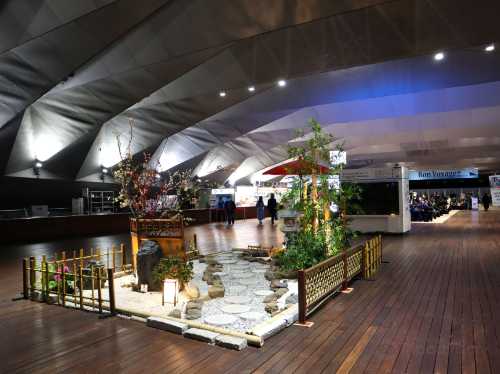Popular Trip Moments
Spring Outing to Satoyama Garden – A Floral Paradise | [Kamakura Alps: From the hidden areas of Kita-Kamakura, Yamanouchi, and Imaizumi to Nikaido. Sansaigaike Park, Inyo Falls, and Tenen Hiking Course] | Sankeien Garden Illumination ✨🌙 Enjoy the fantastic Japanese night view | Yokohama Far East Village Hotel | Yamashita Park in Yokohama | Minato Mirai 21, Yokohama: A Seaside Journey Through Time and the Future | Habour view park in spring | Yokohama Chinatown Tianhou Temple | Spring Blooms at Yamashita Park🌷 | [Welcome spring at the Yokohama New Grand Hotel and Hikawa Maru, with cherry blossoms in full bloom, and Yamashita Park] | Afternoon tea love&table | Dockyard Garden | Minato Mirai Night Stroll Snapshots: Enchanting Scenery of Light and Shadow | Beautiful spots in Tokyo | 📍Sakuragicho Washington Hotel/Kanagawa | Yokohama Sakuragicho Resol Hotel | 7-Day Japan Family Trip: A Super Detailed Guide | Yokohama/TOP-level oyster ramen. Packed with oysters. | Chasing Sakura at Yamashita Park Yokohama | Chasing Sakura at Ookagawa River | Chasing Sakura at Minato Mirai Yokohama | Chasing Sakura at Yokohama Prefecture | 🌸 Secret Cherry Blossom Viewing Spot in Yokohama | 📍Driveway | Sankeien Garden – "A Timeless Sakura Escape" | Tokyo is beautiful, but then I went here… | [Kanagawa/Chinatown] If you're looking for authentic Cantonese Chinese food, this is the place to go!! *Manchinro Main Branch* | [🇯🇵Yokohama] A day to enjoy the exotic atmosphere of Yokohama Chinatown and the winter seasonal tradition of Yokohama Christmas Market | 🛳️ Yokohama Day Tour|Cable Car・Red Brick Warehouse✨ | Miyajima, Itsukushima Shrine (Hiroshima) | [Minato Mirai] A coveted hotel with a distinctive building🏨🚢🤍
Popular Travel Types
Recommended Attractions at Popular Destinations
Bangkok attraction near me | Manila attraction near me | Tokyo attraction near me | Taipei attraction near me | Hong Kong attraction near me | Seoul attraction near me | Kuala Lumpur attraction near me | Los Angeles attraction near me | Shanghai attraction near me | New York attraction near me | Shenzhen attraction near me | Osaka attraction near me | Singapore attraction near me | London attraction near me | Guangzhou attraction near me | San Francisco attraction near me | Beijing attraction near me | Macau attraction near me | Bali attraction near me | Jakarta attraction near me | Paris attraction near me | Ho Chi Minh City attraction near me | Istanbul attraction near me | Phuket attraction near me | Chicago attraction near me | Seattle attraction near me | Toronto attraction near me | Orlando attraction near me | Cebu attraction near me | Chiang Mai attraction near me
Popular Attractions
Genting Highlands Premium Outlets Cable Car | Virtual Reality park Dubai Mall | Museu Do Grande Prémio De Macau Macao Grand Prix Museum | Munich Residenz | Yas Waterworld Abu Dhabi | Daming Lake Scenic Area | Noah's Ark | Perdana Botanical Garden | Heidi's House | Dubai Creek Night Cruise | Palm Jumeirah Monorail | Yangshuo Butterfly Spring Scenic Area | Aquaria Phuket | Qingdao Olympic Sailing Center | Aquaria KLCC | Animal Park - Kissir El Aouana | The Museum of Modern Art | Blue Terra Spa Chandigarh | Kuautlán Ecological Park | Bowling Stadium de Saint Gratien | Oboshi Shrine | Safari Kids Club | Gg.Guru Garden | Wurtzburger Sculpture Garden | Wood Valley Temple | Open Space | چاہ دین محمد والا خانپور | Corning Park | Sha Mian | Inside Burj Al Arab Tour
Popular Restaurants in Yokohama
Oshima Yokohama | CAMBUSA | Nadaman Yokohama-Branch | Cafe Tosca | Yokohama Nadamanhinkan | Masago Saryo | Ristorante Umiria | Saikoushinkan | Shigorokusaikan | Hard Rock Cafe Yokohama | PIER 21 | MILANO | GRILL | Queen Alice Yokohama | Chinese Restaurant Sai-Ryu | Sky Lounge - Bay View | Brasserie Milly La Foret | Teppanyakisagami | Coffee House The CAFE | Azamino Ukai-tei | Bishokumaimon Yokohama | Yugyoan Tankumakitaten | Ocean Terrace | AFRO TACOS | Charcoal Grill green BASHAMICHI | Ko-No-Hana | Nikitei | Revo Brewing | Bairin | Bar "Bay West" | Haraguro-Ya Yokohama
Popular Ranked Lists
Popular Luxury Hotels Near Tonosho | Top 4 Best Things to Do in Mohe | Top 10 Local Restaurants in Naha | Popular Best Things to Do in Gulin | Popular Luxury Hotels Near Wuppertal | Popular Best Things to Do in Heyuan | Popular Luxury Hotels Near Taean-gun | Popular Luxury Hotels Near Century City | Top 9 Best Things to Do in Liangshan Prefecture | Top 5 Best Things to Do in Jingxi | Popular Best Things to Do in Lichuan | Top 10 Local Restaurants in Luxor | Popular Luxury Hotels Near Norwich | Top 9 Best Things to Do in Turpan | Top 4 Best Things to Do in Golmud | Popular Luxury Hotels Near Fukushima | Popular Best Things to Do in Taoyuan | Popular Luxury Hotels Near Naxos | Popular Luxury Hotels in Kathmandu | Top 6 Best Things to Do in Daxing'anling | Popular Restaurants for Views & Experiences in Baja Sardinia | Popular Best Things to Do in Longchang | Popular Premium Hotels Near Dearborn | Popular Best Things to Do in Manzhouli | Popular Luxury Hotels Near Montelimar | Popular Luxury Hotels Near Higashiagatsuma | Top 4 Best Things to Do in Sanjiang | Popular Luxury Hotels in Mirbat | Top 4 Best Things to Do in Huidong | Top 8 Best Things to Do in Aksu Prefecture
Payment Methods
Our Partners
Copyright © 2025 Trip.com Travel Singapore Pte. Ltd. All rights reserved
Site Operator: Trip.com Travel Singapore Pte. Ltd.
Site Operator: Trip.com Travel Singapore Pte. Ltd.





















